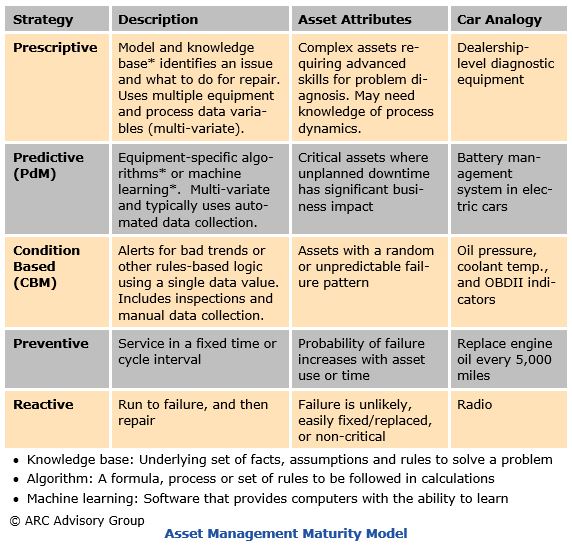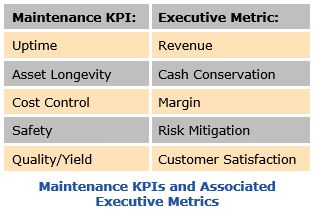

With the emergence of Industrial IoT (IIoT), collecting data from equipment is moving from paper-based, manual inspections to automated systems. This improves both data quality and quantity. IIoT-enabled remote asset monitoring also dramatically expands the number and variety of parameters that can be monitored cost effectively. Combined with today’s more advanced analytics, these data enable industrial organizations to implement new, more effective maintenance strategies to progress further along on the maturity continuum from reactive, to preventive, to condition-based, to predictive, and – ultimately – to prescriptive maintenance.

With higher maintenance maturity, comes broader business benefits that go beyond reducing maintenance costs. These include improved on-time shipments, revenue, customer satisfaction, quality/yield, safety, and work-in-process (WIP) inventory. These benefits align with executive metrics; increasing the likelihood of obtaining both approval for projects and the resources needed for project success.
Range of Maintenance Maturity Expands
For maintenance-related activities, IIoT brings a need to revisit the higher levels of maintenance maturity and associated definitions. A recent review of current maturity models uncovered many versions and inconsistencies. Also, the industry lacks a standard to build upon. This lack of clarity makes it difficult to compare solutions, leading to confusion among potential users and delaying the application of solutions.
While industry participants generally have a good understanding of both reactive and preventive maintenance, we’ve encountered a variety of interpretations for condition-based, predictive maintenance and prescriptive maintenance approaches, and where IIoT comes into play. A clearer definition of these upper maintenance maturity levels is needed for users to be able to better assess the available alternatives.
Expanded Maintenance Maturity Model
Since first publishing the Asset Management Maturity Model in an ARC report in 2015, we’ve taken a closer look at the impact of IIoT on the maturity model. We now classify maintenance maturity into five types or levels: reactive, preventive, condition-based, predictive, and prescriptive.

Reactive Maintenance:
Reactive (run to failure) maintenance is the most common approach for equipment, since most assets have a very low probability of failure and are non-critical. This approach helps control maintenance costs, but is only appropriate for non-critical assets.
Preventive Maintenance:
Here, maintenance is performed based on either time (analogous to replacing the batteries in your household smoke detectors once a year), or usage (changing your car's oil every 5,000 miles). Preventive maintenance applies to assets with an age-related failure pattern where the frequency of failure for the asset increases with age, run-time, or number of cycles.
Condition-Based Maintenance:
Condition-based maintenance (CBM) involves monitoring a specific asset parameter. The focus tends to be the amplitude of the value, with vibration monitoring being the most common. CBM typically applies to production (rotating equipment) and automation (instruments and the control system) equipment. For stationary plant equipment such as steam boilers, piping and heat exchangers, periodic inspections and condition evaluations are often used.
Predictive Maintenance:
Predictive maintenance (PdM) uses engineered algorithms and/or machine learning with multiple input parameters to provide higher accuracy (fewer false positives or missed issues) and more advanced warning before failure. It combines “small data” from a particular device or system with algorithms that model that type of equipment (sometimes called virtual equipment or “digital twin”) to monitor condition and raise an alert when appropriate. This provides the more advanced notice needed to schedule and execute the maintenance during planned shutdowns.
Prescriptive Maintenance:
Prescriptive maintenance builds on PdM with alerts that provide diagnostics and guidance for repair. Information for determining the timing and impact of failure is also included to help assess priority and urgency.
Increasing maturity typically involves more engineering investment. For specific types of equipment, one benefit of the engineered algorithm or model for predictive and prescriptive maintenance is the ability to replicate it like a template across many similar devices – like doors on a passenger train or transformers in power transmission lines. This approach provides economies of scale and a basis for financial justification of the inherently larger engineering and development costs.
Benefits of Higher Maintenance Maturity
 Users have reported that moving from preventive maintenance to predictive or prescriptive approaches provides 50 percent savings in maintenance labor and MRO materials. With predictive and prescriptive maintenance, near zero unplanned downtime for critical equipment can be achieved. This level of equipment reliability ripples into other significant business benefits, including improvements in on-time shipments, revenue, customer satisfaction, quality/yield, safety, and work-in-process (WIP) inventory.
Users have reported that moving from preventive maintenance to predictive or prescriptive approaches provides 50 percent savings in maintenance labor and MRO materials. With predictive and prescriptive maintenance, near zero unplanned downtime for critical equipment can be achieved. This level of equipment reliability ripples into other significant business benefits, including improvements in on-time shipments, revenue, customer satisfaction, quality/yield, safety, and work-in-process (WIP) inventory.
Unfortunately, maintenance and operations personnel tend to focus on cost reductions for labor and MRO materials to financially justify a project. A broader viewpoint with higher business impact usually gets executive attention and the resources needed to succeed.
Recommendations
Industrial IoT allows organizations to move from manual inspections to collect data, to automated systems. This vastly improves data quantity and quality, enabling improvements in maintenance strategies. How can you best leverage this capability to improve your organization’s operating performance? Based on ARC research and analysis, we recommend the following actions for plant owner-operators:

